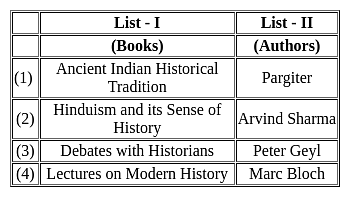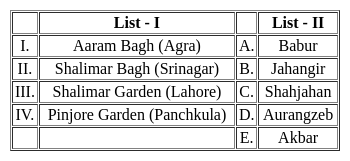UGC NET Paper 2 History Mock Test - 7 - UGC NET MCQ
30 Questions MCQ Test - UGC NET Paper 2 History Mock Test - 7
When was the Panchsheel formally enunciated?
How many gates and towers were mentioned by Megasthenes in Mauryan capital, Pataliputra?
| 1 Crore+ students have signed up on EduRev. Have you? Download the App |
Consider the following statements regarding the evolution of different stages of Stone Age in Indian subcontinent?
1. Around 12,000 years ago men, women and children probably collected the grains as food and learnt where they grew.
2. The beginning of the Neolithic age dates back to 1,00,000 years ago.
3. People were familiar with the use of fire in Paleolithic age.
Which of the statements given above is/are correct?
Consider the following statements:
1. Desai-Liaquat Pact proposed an equal number of persons to be nominated by Congress and the Muslim League in the Central Legislature.
2. The Rajagopalachari Formula was accepted by the Muslim League.
Which of the statement(s) given above is/are correct?
Which of the following statements are correct about the Wahabi movement of the 19th century?
a. Started against Sikhs of Punjab and later against the East India Company.
b. Inspired by teachings of Abdul Wahab of Arabia.
c. Inspired by teachings of Delhi saint Shah Waliullah.
Select the correct answer using the codes given below:
Which of the following is not correctly matched:

Consider the following statements with respect to the emergence of the Bhakti Movement.
1. The Rajput-Brahmanial alliance was hostile to heterodox movements.
2. The loss of patronage to temples brought down Brahmanical hegemony.
3. This paved way for the emergence of non-conformist movements.
Which of the above statements is/are correct?Which pillar is referred to in the passage?
Consider following statements in the context of 1858 revolt?
A). Mutineers had good understanding of colonial ideology and British machinery
B). Mutineers planned a progressive social and political change after overthrowing East India company rule.
C). Tatiya tope died in Jhansi while fighting alongside Rani Laxmibai.
Which of the above statement/s is right?
Consider the following
1). Liaqat Ali
2). Nizam of Hyderabad
3). Sikh rulers of Patiala
4). Holkar of Indore
Which of the above did not participate in 1857 revolt?
From the time England acquired political power in India, she destroyed Indian Industries principally by means of:
1) Forcing of British Free Trade on India.
2) Compelling Old East India Company merchants to divulge their trade secrets.
3) The export of raw products from India.
4) Building railways in India.
Which of the above statements are correct.
List-I denotes the Mughal Gardens and List-II denotes the rulers under whose reign the Gardens were built. Match the two lists correctly.

Choose the correct code:
- It was formed by Pitts India Act of 1784
- It controlled the commercial matters of the company
- It was abolished by the Government of India Act 1858
Consider the following statements regarding the Guptas:
- Srigupta was the first Gupta king whose name got mentioned in the Allahabad Pillar inscription.
- The Devichandraguptam mentioned the murder of Ramagupta by Chandragupta II.
- The Bhittari Stone Inscription mentioned the defeat of Hunas by the Skandagupta.
Which of the statements given above is/are correct?
'Chachnama' is a famous work on the History of
Consider the following statements regarding Chauth and Sardeshmukhi:
1. Sardeshmukhi was an additional levy of ten percent on those lands which the Marathas claimed hereditary rights.
2. Chauth was one fourth of the land revenue paid to the Marathas in order to avoid the Maratha raids.
Which of the statements given above is/are correct?
Which of the following statement(s) about the India election of 1945 is/are correct?
1. Congress emerged as the largest party by capturing 52 of 109 seats in the Central Assembly.
2. Muslim league captured all the Muslim reserved seats in the Central Assembly.
3. In the provincial elections, the Muslim league got a majority in Bengal, Punjab, and Sindh.
Select the correct code from below:
Which of the following statements about Annales historians are true?
A. Annales School was name after the journal Annales.
B. Annales historians see history in terms of movement from past to the future.
C. Annales historians insist that they do not represent a school.
D. Annales school has influenced history writing in many countries including India.
With reference to Lord Wellesley, consider the following statements:
1) The Civil Service was brought into existence by him.
2) He also established the College of Fort William for the education of young recruits to the Civil Services.
Which of the statements given above is/are correct?
Which of the following is a collection of magic spells and charms to ward off the evil spirits and diseases?
Which among the following principles was/were propagated by the Theosophical Society?
Chronologically arrange the following treaties signed by the British with Native States and select the correct option:
I. The Treaty of Salbai
II. The Treaty of Bassien(Vasai)
III. The Treaty of Srirangapattanam
IV. The Treaty of Allahabad and Kara
The Santhal rebellion started under which of the following?


















